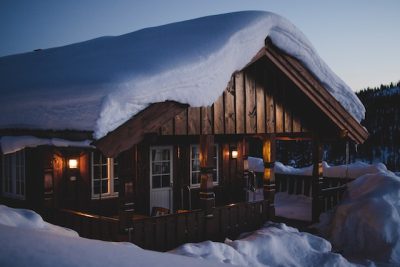Proper preparations help maintain a warm and moisture-free environment throughout winter, preventing potential damage and ensuring your comfort. Additionally, it can help prevent major health issues down the line.
In addition to addressing potential repairs and upgrades, winterizing your house also improves energy efficiency by eliminating sources of cold air infiltration. For instance, reducing drafts may save 5 to 30% of electricity in a home per year. Without proper preparation, you may face significantly higher electricity bills.
The impact of high electricity bills can be harrowing in areas like Babylon, where electricity is charged at a rate of 19.03¢/kWh, which is 60.19% higher than the country’s average rate of 11.88¢/kWh. In such a situation, preparing your house effectively for winter to avoid excessive utility costs while keeping your home warm becomes even more critical.
Below are some upgrades and repairs that must not be overlooked.
1. Check HVAC system
Checking the HVAC system in your house is crucial to ensure your home remains comfortable, adequately warm, efficient, and cost-effective during the winter season. A well-maintained HVAC system maintains the indoor temperature while ensuring better indoor air quality and energy savings.
When checking the HVAC system in the house, pay attention to the furnace or heat pump. Clean or replace the filters—dirty filters can block airflow, forcing the system to work harder to maintain the internal temperature.
Ensure the thermostat is working properly and calibrated accurately. If feasible, consider upgrading to a smart thermostat that manages your house’s internal temperature by understanding your heating preferences, thus saving energy. Making sure your HVAC system is in optimum condition is particularly essential in places like Babylon, where winters are cold and windy, and the temperature could drop to as low as 12F!
Make sure you hire experts experienced in Babylon HVAC services for a thorough inspection. HVAC technicians can identify signs of wear and tear, examine ductwork for leaks or damage, and repair any issues causing a significant loss of heated air.
2. Inspect the roof
The roof protects your home from external elements, which also means it faces the brunt of extreme weather conditions, leading to degradation over time.
Before the onset of winter, get your roof inspected to ensure it is ready for the cold wind, snow, and other elements associated with winter. Proper roof management is crucial to avoid water damage reaching the building’s foundations.
Some things to pay attention to when inspecting your roof are the following:
- Deteriorating leadwork
- Debris blocking the roof valleys
- Slipped slates or tiles
- Flashings, junctions, and ridges
Here is what you should aim for when repairing and upgrading the roof:
- All the tiles are in their place, and none is missing
- There is no space and inlet for water ingress
- There are no damp areas inside the loft
- There are no leaves or moss that can cause water to accumulate
If you find issues during the inspection, make sure professional roofing contractors immediately address them.
3. Inspect the chimney
When inspecting the roof, spend some time assessing the condition of the chimney, too. Chimneys are often considered a vulnerable part of the house. As they protrude from the roof, they are exposed to cold air, snow, and frost.
If you see any issues with the chimneys, repair them yourself or call a professional. Minor issues like cracks can quickly be addressed at home with patching cement or 100% silicone caulk. However, for significant damages, you will need expert help.
In addition to repairing cracks and issues, consider adding a chimney cap or cowl to reduce downdrafts, thereby improving your stove’s efficiency.
4. Unclog the drains and gutters
While you are winterizing your house and have taken out your ladder and other tools, why not take it as an opportunity to unclog and clean gutters and drains? This involves removing leaves and debris to prevent water from overflowing and ruining the walls. If pine trees are near your house, remove needles at least four times a year to avoid gutters and downspouts from clogging. Overlooking gutter and drain maintenance can lead to more expensive repairs down the line.
Additionally, inspect gullies and downpipes while unclogging the gutters and drains to ensure they are in good shape. Gutter brushes are great for keeping the drains unclogged by catching leaves and debris, making annual cleaning a much quicker and hassle-free practice. Additionally, gutter brush guards also deter rats, rodents, and birds.
5. Inspect the exterior walls
Regardless of the material used on the exterior walls of your house, they can be damaged when exposed to strong winds and wet and frigid weather. Therefore, checking the exterior walls must be part of your drive to winterize the house.
Here is what you must pay attention to when inspecting exterior walls:
- Signs of cracking: cracks can cause moisture to penetrate and cause more damage as time passes. Neglecting them could lead to costly repairs or the need for stone restoration services if you have a masonry exterior.
- Rot: wooden sidings, trim, or any wood components must be examined closely for soft spots, discoloration, or wood that easily crumbles when touched
- Condition of the paint and finishes: Peeling or chipping paint indicates the protective barrier is compromised
- Masonry or brickwork: Inspect them for loose or deteriorating mortar
6. Inspect pipes
Frozen pipes can be a major headache; they don’t only disrupt your water supply but can also impact the integrity of your house’s plumbing system. When water freezes, it causes the pipes to burst, potentially flooding your home. Insulate the pipes in the house’s exterior, attic, and other unheated areas to diminish the chance of pipe freezing and subsequent pipe bursts and flooding.
7. Inspect your windows and doors
During summer, you might have kept your doors and windows open or on the latch to let fresh air in. Now that winter is coming, you must ensure that all the windows and doors in the house can shut tightly and are ready to keep the cold at bay. Look for issues like peeling paintwork, loose joints, and broken handles. You may fix some problems at home, but some may require professional assistance.
In addition, look for gaps and holes in the windows and doors that allow cold air to infiltrate the warm inside space. Seal them properly to ensure a comfortable indoor environment and to reduce pressure on your heating system.
Conclusion
Winterizing your house ensures it remains warm and safe when freezing weather hits it. The best time to winterize your house is the end of the summer and the start of fall. This way, you can rest easy when the first frost hits your home. There are numerous ways to prepare your home for winter; some of those ways are mentioned in the article above. Follow these tips depending on the intensity of your local weather to keep your house safe.












